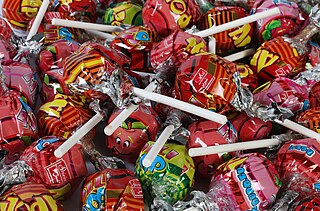 W
WĀbnabāt is a kind of Persian hard candy made of sugar boiled with added flavours. There are many different kinds of Abnabat, such as Abnabat Gheichi.
 W
WZahra Ahmadipour is an Iranian politician and university professor who was the head of Cultural Heritage, Handcrafts and Tourism Organization from 2016 until 2017. She was formerly Director of administrative divisions of the Ministry of Interior for two times, first from 1997 until 2003 and second time in 2016. She was also Vice President of the Physical Education Organization from 2003 until 2005.
 W
WBaghali polo is a popular Iranian dish of rice, fava beans and dill. In Persian, baghali means fava bean while polo is pilaf, a style of cooked rice. It is made by cooking rice and green broad beans in boiling water. When cooked, the rice and beans are layered with dill in a pan, and everything is baked in an oven until ready. Saffron water can also be added to the rice. It is typically served with meat.
 W
WBonab kabab is a type of kebab that is made of ground mutton, onion, and salt. It is named after the city of Bonab in the region of Azerbaijan in northwestern Iran, where it is originated from, and is famous for its large size.
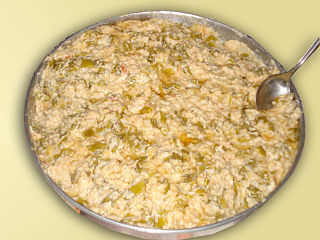 W
WBorani is a salad dish from Iranian cuisine. It is also found in Turkish cuisine where it is associated with certain provinces like Isparta, Urfa and Van. Some versions are made with spinach and yogurt, while the Ancient Persian borani was made with eggplant, and a regional version from Urfa is made with lamb and vegetarian meatballs. Borani is also popular in the Caucasus and Afghanistan.
 W
WBozbash is a meat stew popular in Armenia, Azerbaijan and Iran.
 W
WChickpea noghl, or sugar-coated Chickpea, is a traditional Iranian and Afghan, Turkish confection. It is made by boiling sugar with water and rose water and then coating roasted chickpea in the mixture.
 W
WEris or Riss is one of Tabriz's most popular confections. It is made of pistachio, milk, sugar, vanilla, and butter.
 W
WFesenjān is an Iranian stew from Northern Iran. It is also eaten in the Republic of Azerbaijan.
 W
WGheimeh or qeimeh is an Iranian stew (khoresh) consisting of diced mutton, tomatoes, split peas, onion and dried lime, garnished with golden thinly sliced crispy potatoes. The stew is sometimes garnished with fried eggplant and is usually served with white rice (polow).
 W
WGosh-e fil is a fried pastry from Iranian cuisine and also popular in Afghanistan. The dough is shaped like an elephant ear (goosh), and deep-fried in oil. Each piece is then topped with chopped pistachios and powdered sugar.
 W
WBiryan Isfahan is one of the traditional dishes of Isfahan, Iran, a fried meat served on a piece of bread with onion and greens on the side.
 W
WJujeh Kabab is an Iranian dish that consists of grilled chunks of chicken which are sometimes with bone and other times without bone. This is one of the most common and popular dishes of Iran. It is common to marinate the chunks in minced onion, lemon juice and saffron.
 W
WKabāb-e Barg is a Persian style barbecued and marinated lamb, chicken or beef kabab dish. The main ingredients of Kabab-e Barg are beef tenderloin, lamb sirloin, or less commonly chicken breast, along with onions and olive oil.
 W
WKabab torsh is a traditional kebab from Gilan and Mazandaran provinces in Iran. It is made with beef, usually sirloin or tenderloin, in recent years it has been made with chicken too. Red or white meat is marinated in a paste made of crushed walnuts, pomegranate juice, chopped parsley, olive oil, and crushed garlic.
 W
WKashk o bademjan or kashk-e bademjan is an Iranian dish, that literally translates in Persian as “kashk and eggplant”. It can be considered either an appetizer or a main dish. There are various recipes for this dish, involving caramelized onions, roasted nuts, herbs and spices.
 W
WKhoresh or Khoresht is a generic Iranian term for stew dishes in the Iranian cuisine, Afghan cuisine, Tajik cuisine and also Kurdish cuisine. The word is a substantive of the verb khordan "to eat" and literally means "meal".
 W
WKhoresh bademjan is a Persian stew of eggplant and tomatoes. The word khoresh means "stew," and bādemjān means "eggplant."
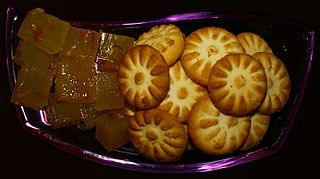 W
WKoloocheh is a Persian cookie made in various parts of Iran. Koloochehs from southern Iran are brittle biscuits that principally consists of water, sugar, wheat flour and egg white. Koloocheh are souvenirs of Shiraz.
 W
WLoobia polo is an Iranian dish of rice, green beans, and beef or lamb. In the Persian language, loobia means bean while polo is a style of cooked rice, known in English as pilaf. It is made by sautéing onion with a touch of turmeric powder followed by mixing the beef, then adding the cooked green beans with salt and pepper. You can alway add cinnamon for an extra sense of flavor. This is then layered with half-cooked rice in another pot and steamed until done.
 W
WMangal is a Middle Eastern barbecue—both the event and the grilling apparatus itself.
 W
WThe Ministry of Agriculture Jihad is an Iranian government body established in 2001 responsible for the oversight of Agriculture in Iran. The ministry has been called Jihad of Construction but it was merged with agriculture ministry in 2001 to form the Ministry of Agricultural Jihad.
 W
WMirza ghassemi or mirza qassemi is an Iranian appetizer or main based on tandoori or grilled aubergine (eggplant), distinct to the Northern Iran and Caspian Sea region. It is known as Persian eggplant dip in Western countries.
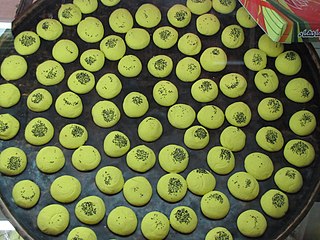 W
WNan-e berenji, also called shirini berenji, is an Iranian rice-flour cookie originating from Kermanshah. Nan-e berenji literally translates to "rice bread". It is often flavored with cardamom, garnished with poppy seeds and formed into flat disks. They are usually white, but sometimes tinted yellow.
 W
WNan-o kabab is a national dish of Iran. The meal is simple, consisting of kabab, of which there are several Iranian varieties, and a type of Iranian flat bread. It is served everywhere throughout Iran today, but traditionally was associated with the southern and central parts of the country, and probably originated in the province of Fars.
 W
WNan-e nokhodchi, also called shirini nokhodchi, are cookies made from chickpeas originating in Qazvin, Iran. These are traditionally made from chick-pea flour and flavored with cardamom and garnished with pistachio. They come in varying shapes.
 W
WMlabbas, and Noghl, or Nuql, or sugar-coated almonds, is a traditional Syrian, Iranian and Afghan confection. It is made by boiling sugar with water and rose water and then coating roasted almonds in the mixture. It can also be made with other nuts such as walnuts or other items. Noghl is often eaten along with tea.
 W
WPashmak is a form of Iranian candy floss or cotton candy, made from sugar. Pashmak is served on its own or as an accompaniment to fruits, cakes, ice creams, puddings and desserts. It is widely known as Persian Cotton Candy. It is sometimes garnished with ground pistachio nuts. Although the texture is similar to cotton candy, both method and ingredients are different.
 W
WPomegranate soup is an Iranian and Iraqi dish made from pomegranate juice and seeds, yellow split peas, mint leaves, spices, and other ingredients. It is regarded as an āsh, which is the Iranian term for a "thick soup".
 W
WQottab is an almond-filled deep-fried Iranian cuisine pastry or cake, prepared with flour, almonds, powdered sugar, vegetable oil, and cardamom. The city of Yazd is well known for its qottab.
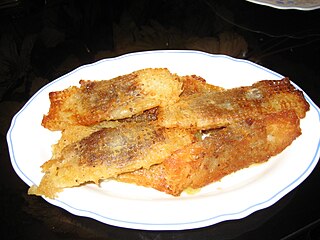 W
WReshteh khoshkar is the traditional cookie for Ramadan in Gilan Province, Iran. It is made of rice flour, and filled with sugar, ground walnuts or hazelnuts, cardamom, cinnamon, ginger and spice, fried in hot oil or fat. Made of rice flour, wheat flour, sugar, almonds, walnuts, and cinnamon, it is slowly fried in oil. Rice flour batter is poured in a small container with multiple holes such that the rice batter runs out of it as fountain. This container is then used to make a pattern on a hot skillet with the running rice batter. The hot skillet firms up the rice batter and makes a thin patterned sheet of rice pastry. A filling of crushed walnuts, sugar and sometimes other ingredients is placed in the center of the pastry and folded securely. This is then fried in oil and enjoyed.
 W
WSabzi polo is an Iranian (Persian) dish of rice and chopped herbs, usually served with fish. In Persian, sabzi refers to herbs or vegetables ; polo is pilaf, a style of cooked rice.
 W
WSaffron rice is a dish made from saffron, white rice and also usually vegetable bouillon. Saffron rice is found in the cuisines of many countries. The recipe is similar to plain cooked rice with addition of ingredients.
 W
WIraqi samoon or stone samoon is a type of yeast bread that is consumed mainly in Iraq. It is baked in traditional stone ovens, like pizza. This bread is one of the most widespread breads in Iraq, along with khubz. It is usually served with a variety of foods such as hummus, kebab, and shawarma. It is one of the most popular breads used in Iraq and across the Levant and variants can be found in Syria and Lebanon. It can be also found in other Middle Eastern and European countries among Iraqi Diaspora.
 W
WSangak or nân-e sangak is a plain, rectangular, or triangular Iranian whole wheat leavened flatbread.
 W
WSohan is a traditional Persian saffron brittle toffee made in Iran. Its ingredients consist of wheat sprout, flour, egg yolks, rose water, sugar, butter or vegetable oil, saffron, cardamom, and slivers of almond and pistachio.
 W
WKufteh Tabrizi, also known as Tabriz Köftesi, is an Iranian meatball recipe from the city of Tabriz. The dish normally includes a big meat ball with meat, rice, yellow split peas, herbs and other ingredients and its juice which is served in a separate dish with shredded Sangak or Lavash bread before the main course.
 W
WTabrizi Lovuez are diamond-shaped confectioneries from Tabriz, a provincial capital in Northwest of Iran. Its main ingredients are sugar, almond powder, and saffron.
 W
WTaftan or Taftoon is a leavened flour bread from Iranian, and Pakistani cuisines. It is made with milk, yoghurt, and eggs and baked in a clay oven. It is often flavoured with saffron and a small amount of cardamom powder, and may be decorated with seeds such as poppy seeds.
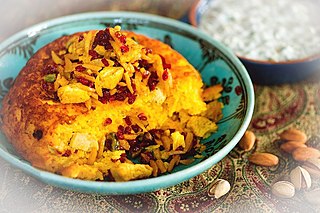 W
WTahchin is an Iranian-Kurdish rice cake primarily consisting of rice, yogurt, saffron, and eggs. Some versions of the dish are more elaborate, folding in chicken fillets, vegetables, fish, or red meat. Tahchin is composed of two different parts: the thin Tahdig part which includes the chicken fillets, saffron, and other ingredients at the bottom of the cooking pot and the second part which is the white rice. In restaurants, tahchin is mostly prepared and served without the white rice part.
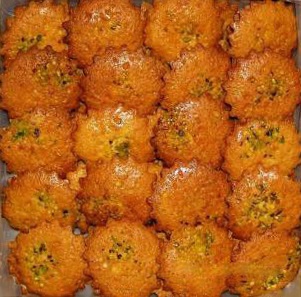 W
WYazdi cake is a cake native to Yazd in central Iran and is mostly used in Yazd Province itself for different ceremonies.
 W
WZanjan rug or Zenjan rug is the handmade Iranian carpet from Zanjan.